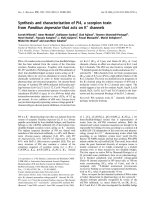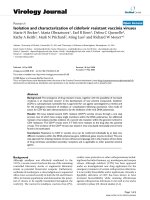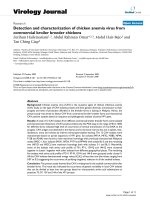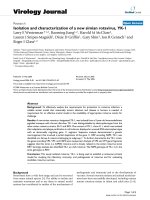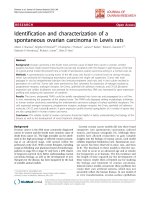Báo cáo hóa học: " Synthesis and Characterization of Core-shell ZrO2/PAAEM/PS Nanoparticles" pptx
Bạn đang xem bản rút gọn của tài liệu. Xem và tải ngay bản đầy đủ của tài liệu tại đây (492.29 KB, 7 trang )
NANO EXPRESS
Synthesis and Characterization of Core-shell ZrO
2
/PAAEM/PS
Nanoparticles
J. Wang Æ T. J. Shi Æ X. C. Jiang
Received: 5 November 2008 / Accepted: 2 December 2008 / Published online: 16 December 2008
Ó to the authors 2008
Abstract This work demonstrates the synthesis of core-
shell ZrO
2
/PAAEM/PS nanoparticles through a combina-
tion of sol–gel method and emulsifier-free emulsion
polymerizaiton. By this method, the modified nanometer
ZrO
2
cores were prepared by chemical modification at a
molecular level of zirconium propoxide with monomer of
acetoacetoxyethylmethacrylate (AAEM), and then copoly-
merized with vinyl monomer to form uniform-size hybrid
nanoparticles with diameter of around 250 nm. The mor-
phology, composition, and thermal stability of the core-
shell particles were characterized by various techniques
including transmission electron microscopy (TEM), X-ray
diffractometer (XRD), Fourier transform infrared spec-
troscopy (FTIR), X-ray photoelectron spectroscopy (XPS),
and thermal-gravimetry analyzer (TGA). The results indi-
cate that the inorganic–organic nanocomposites exhibit
good thermal stability with the maximum decomposition
temperature of *447 °C. This approach would be useful
for the synthesis of other inorganic–organic nanocompos-
ites with desired functionalities.
Keywords Core-shell Á ZrO
2
/polmer nanocomposites Á
Sol–gel method Á Polymerization
Introduction
The strategy for designing and fabricating organic–inor-
ganic nanocomposite particles has attracted considerable
attention because of their novel and enhanced properties,
including mechanical, chemical, optical, rheological, and
electrical properties [1–4]. A variety of methods have been
demonstrated for generating nanocomposite particles in the
past decades. Some investigators reported that such nano-
composites could be prepared by encapsulation of
inorganic particles in a polymer shell [5, 6], in which the
effect of compounding was closely related to the dispersion
stability of inorganic particles in polymerized media. The
monodispersed suspension of inorganic nanoparticles is,
however, not easily obtained because of its high surface
energy in organic solvents and/or polymer media, which
results in a wide distribution of particles finally. To over-
come the difficulty in obtaining homogenous dispersion of
inorganic particles, the sol–gel technique is commonly
used for the synthesis of organic–inorganic advanced
materials, which can offer the possibility to design nano-
composite structure at a molecular level. Recently, the
emulsion copolymerization method has been widely used
for the synthesis of hybrid nanoparticles such as SiO
2
/
polymer [7–10], and TiO
2
/polymer [11–13] by chemically
modifying the sol of metal oxides. Such an approach could
provide a facile access to the preparation of shape/size-
controlled nanocomposites. In our previous study [9], the
core-shell SiO
2
/PAA/PS nanoparticles were synthesized
through the combination of sol–gel method and a dispersed
polymerization approach, where the functional silica par-
ticles structured with vinyl groups on their surfaces were
synthesized by the hydrolysis and polycondensation of
tetraethoxysilane. The vinyltriethoxysilane (VTEOS) was
used as a silane agent to form cores which were used as
J. Wang Á T. J. Shi (&)
School of Chemical Engineering, Hefei University of
Technology, Hefei 230009, People’s Republic of China
e-mail:
X. C. Jiang
School of Materials Science & Engineering, University of New
South Wales, Sydney, NSW 2052, Australia
123
Nanoscale Res Lett (2009) 4:240–246
DOI 10.1007/s11671-008-9232-3
seeds to copolymerize with styrene and acrylic acid to form
SiO
2
/PAA/PS nanoparticles. In comparison with the tran-
sition metal alkoxides such as VTEOS and Ti(OBt)
4
, the
hydrolysis and condensation reactions of zirconium alk-
oxides (Zr(OPr
n
)
4
) are too active to be controlled in the
preparation of ZrO
2
/polymer core-shell nanoparticles,
although they have shown interesting functional properties
and potential applications in many areas[14]. To achieve
hybrid ZrO
2
nanocomposites, strong complexing ligands
were commonly used as stabilizing agents for non-silicate
metal alkoxides precursors [15]. The commonly used
chelating ligands could be b-diketones and allied
derivatives such as polyhydroxylated polyols and a-or
b-hydroxyacids. It was recently found that the acetoacet-
oxyethylmethacrylate (AAEM) could act both as a strong
chelating agent and a highly reactive methacrylate group,
which, therefore, readily polymerize with the other vinyl
monomers through chemical bonds. Moreover, the emul-
sifier-free emulsion polymerization has been proved to
effectively eliminate the shortcomings of emulsifier that
could lead to negative effects on the material properties
[16, 17], and it is a potentially practical method in pre-
paring environmentally friendly core-shell nanoparticles.
During the polymerization, the use of polar solvent and
another hydrophilic monomer would be helpful to increase
the rate of polymerization and stability of emulsion [18].
However, the details in nucleation and growth of hybrid
ZrO
2
nanocomposites, and their thermal stability need to be
further understood. Therefore, the development of facile
and effective approaches to obtain the desired hybrid ZrO
2
nanocomposites and further understanding on the forma-
tion mechanism is a still challenging task.
In this study, the core-shell ZrO
2
/PAAEM/PS nanopar-
ticles were synthesized through the combination of a sol–
gel method and an emulsifier-free emulsion polymerization
approach. The microstructure and composition of the
as-prepared nanocomposites were characterized by using
various advanced techniques such as transmission electron
microscopy (TEM) and X-ray diffractometer (XRD). The
interactions between inorganic and organic components are
then measured by Fourier transform infrared spectroscopy
(FTIR) and X-ray photoelectron spectroscopy (XPS)
techniques. The thermal gravimetry analyzer (TGA) tech-
nique is finally used to check and evaluate the thermal
stability of the hybrid core-shell nanoparticles.
Experimental
Materials
Zirconium propoxide (Zr(OPr
n
)
4
) (70% in propanol) and
AAEM (99%) were provided by Aldrich Co. and Eastman
Co. (USA), respectively. Propanol (PrOH) was obtained
from Shanghai Reagent Co. (Shanghai, China). Styrene (St,
chemically pure grade) and potassium persulphate (KPS,
chemically pure grade) used as initiators in this study, were
purchased from Tianjin Chemical Factory (Tianjin, China),
and all the monomers were purified prior to use.
Preparation of AAEM-Modified ZrO
2
Sol
Zr(OPr
n
)
4
and AAEM were used as precursors and a
functionalized chelating ligand in the preparation of
AAEM–ZrO
2
sol. The molar ratios of Zr(OPr
n
)
4
/AAEM/
H
2
O/PrOH were fixed at 1:1:10:30 in the reaction system.
The hydrolysis and polycondensation of the AAEM-mod-
ified precursor of Zr(OPr
n
)
4
were conducted in a conical
flask equipped with magnetic stirrer, dropping funnels, and
inlet for nitrogen gas. The reaction was carried out for
*8 h at room temperature. The AAEM-modified ZrO
2
sol
was finally obtained.
Preparation of ZrO
2
/PAAEM/PS Nanoparticles
ZrO
2
/PAAEM/PS hybrid nanoparticles were prepared
through the polymerization of the emulsifier-free emulsion
process. The AAEM-modified ZrO
2
cores were used for
seeds in the formation of ZrO
2
/PAAEM/PS hybrid nano-
particles by copolymerizing with styrene. In this
polymerization process, the mixture of distilled water and
PrOH were used as the reaction medium, and three steps
were involved in a typical synthesis. First, an appropriate
amount of KPS (2 wt% based on monomer), AAEM-
modified ZrO
2
sol, and AAEM (used as the second
monomer, the molar ratio of AAEM/St is 0.2) were added
into the reactor, followed by stirring to make sure the
mixture was homogeneous, along with the heating up to
80 °C. Then the styrene monomer was added dropwise into
the mixed solution. The polymerization was carried out for
4 h further after the feeding was finished. Finally, the
reaction solution was naturally cooled down to room
temperature. The product was separated by centrifugation
and completely rinsed by water and alcohol respectively
for further characterization. The blank sample of PAAEM/
PS nanoparticles was also prepared by means of the similar
emulsifier-free polymerization approach.
Characterization
The morphology and size of the as-prepared hybrid nano-
particles was checked through a H-800 Transmission
Electron Microscopy (TEM) (Hitachi Co., Japan). X-ray
diffraction (XRD) analysis was performed on a D/max-cB
X-ray Diffractometer (Rigaku, Japan) with graphite-
monochromatized CuKa radiation (k = 1.54178 A
˚
). The
Nanoscale Res Lett (2009) 4:240–246 241
123
interaction between inorganic core and organic shell was
examined by FTIR operated on an IR-200 (Thermo Elec-
tron Co., U.S.). Thermal-gravimetry analysis (TGA) was
conducted on a Pyrisl analyzer (PE Co., USA) at a heating
rate of 10 °C/min under nitrogen protection. The elements
of the hybrid nanoparticles were analyzed on VG model
Escalab 250 X-ray photoelectron spectroscope (Thermo.
Electron, USA).
Results and Discussion
Core-shell ZrO
2
/PAAEM/PS Particles
AAEM-modified ZrO
2
sol was prepared by the hydrolysis
and polycondensation of Zr(OPr)
4
. The chelating reaction
between AAEM and Zr(OPr)
4
in propanol was described in
a scheme as below:
where the AAEM molecule plays the dual roles: (i) of
providing chelating bonds for combining with Zr(OPr)
4
that could control the hydrolysis rate of Zr(OPr
n
)
4
, and (ii)
of providing double bonds for copolymerizing with the
other vinyl monomer in the formation of an organic shell.
This would make significant contribution to enhance the
mechanical and thermochemical properties of the hybrid
microspheres. At the second stage, the AAEM-modified
ZrO
2
sol reacted with the styrene monomer to form a
polymer shell around ZrO
2
core, and the reaction equation
could be briefly summarized as below:
Microstructure of Nanocomposites
The morphology and size of the core-shell nanocomposites
was characterized by TEM technique. Figure 1 shows the
TEM image of the ZrO
2
/PAAEM/PS hybrid nanoparticles.
They are spherical in shape and the particle surface seems
smooth with a diameter of ca. 250 nm and a shell thickness of
ca. 25 nm. An obvious contrast between the core and the
shell of the latex particles could be observed in Fig. 1, which
is possibly caused by the difference of electron penetrability
to the inorganic core and the organic shell. Furthermore, the
inorganic ZrO
2
cores were entirely covered by the polymer,
suggesting that the AAEM could modify ZrO
2
homoge-
neously. A close inspection to the core-shell particles reveals
that the core-shell composite particles are of spherical shape
with nearly uniform size, although the size of these ZrO
2
cores is not very uniform as shown in the TEM image.
XRD Analysis
The variety of phases of PAAEM/PS and ZrO
2
/PAAEM/PS
nanoparticles were investigated by XRD technique.
Figure 2 shows a broad peak around 2h = 20° in the XRD
pattern (1) of the PAAEM/PS, corresponding to the typical
characteristic of amorphous polymer. The XRD pattern (2)
of ZrO
2
/PAAEM/PS nanoparticles also shows a broad peak
around 2h = 20° indicating that the hybrid nanocomposites
are amorphous. The peak half-width of ZrO
2
/PAAEM/PS
nanoparticles becomes broader, suggesting that the inor-
ganic component (ZrO
2
) has interpenetrated with organic
polymer chains to be compatible with each other; other-
wise, two separate XRD diffraction domains could be
found [19].
FTIR Spectrum Analysis
To further investigate the bonding characteristics or the
interaction between the inorganic core and the polymer
CH
3
CH
2
CH
2
CH
3
CH
3
C
O
C
O
C
O
H
2
C C
O
O
O
2
Zr
OPr
n
4
H
2
O
CH
2
CH
3
C
O
C
O
H
2
C C
OO
2
CH C
Zr
(1)
CH
3
CH
2
CH
2
CH
2
CH
3
O
CH
2
CH
3
C
O
C
O
H
2
C C
O
O
2
CH
C
C
C
Zr
+CH
KPS
x
CH
2
C
O
O
2
H
y
CH
3
O
C
O
O
CH
C
Zr
(2)
242 Nanoscale Res Lett (2009) 4:240–246
123
shell, the FTIR technique was used to characterize the
organic groups among them. Figure 3 shows the typical
infrared spectra of AAEM, AAEM-modified zirconium
propoxide, and ZrO
2
/PAAEM/PS hybrid nanoparticles.
The polymers and the core-shell structures exhibit the
characteristic stretching peaks of C–H (CH
2
)at
*2,960 cm
-1
and 2,875 cm
-1
, as well as the distortion
vibration peak of CH
2
centered at *1,460 cm
-1
and
*1,410 cm
-1
, respectively. The stretching vibration bands
centered at *1,749 cm
-1
and *1,720 cm
-1
(Fig. 3a)
could be attributed to C=O stretching vibration of the ester
group and keto group, respectively.
Further FTIR analysis provides more information about
the microstructure of the core-shell nanostructures. Strong
vibration peaks located at *1,620 cm
-1
and *1,520 cm
-1
appear in the FTIR spectrum of the AAEM-modified zir-
conium precursor, which correspond to the m(C=O?C=C)
vibration of the enolic form of b- cetoesters [20]. This could
lead to a conclusion that the chelating reaction between
zirconium atoms and AAEM groups occurred. In compar-
ison with the free AAEM monomer, the stretching vibration
of ester group at *1,749 cm
-1
was not observed in the
AAEM-modified zirconium propoxide sol, suggesting that
most of the AAEM monomers were bonded to zirconium
atoms. As a result, the chemical bonds were formed
between the zirconium oxo-polymers and the methacrylate
monomer. The broad band located in the range of 300–
600 cm
-1
could be assigned to the stretching vibration of
Zr–O–Zr of the AAEM-modified zirconium propoxide
(Fig. 3b), and the ZrO
2
/PAAEM/PS nanocomposite
(Fig. 3c), respectively.
Considering the hybrid nanocomposites, the absorption
peaks in FTIR spectra located at around 1,600 cm
-1
,
1,494 cm
-1
, and 1452 cm
-1
could be attributed to the
stretch vibrations of benzene ring, whereas those located at
around 760 cm
-1
and 698 cm
-1
could be attributed to the
banding vibrations of benzene ring originated from poly-
styrene. In addition, the intensity of the characteristic
absorption peak of C=C located at *1,637 cm
-1
decreased
remarkably in comparison to thaht of the AAEM monomer,
indicating that the styrene monomer copolymerized with
the vinyl groups of the AAEM-modified zirconium prop-
oxide. It was also noted that the characteristic C=C peak
located at *1,637 cm
-1
(Fig. 3b) decreased remarkably in
comparison to that of the AAEM monomer, which is
because of the effect of the strong vibration peak located at
1,620 cm
-1
in the AAEM-modified zirconium sole [20].
The results are well in agreement with our proposed
molecular-designed reaction process (see Eqs. 1 and 2).
3500
1520
1620
1637
1720
1749
c
b
a
wavenumber/(cm
-1
)
50010001500200025003000
Fig. 3 Infrared spectra of a AAEM; b AAEM-modified zirconium
propoxide; and c PS/PAAEM/ZrO
2
hybrid nanoparticles
Fig. 1 TEM image of ZrO
2
/PAAEM/PS hybrid nanoparticles
10 20 30 40 50 60
0
500
1000
1500
2000
2
1
Intensity (CPS)
2 Theta (deg.)
1-PAAEM/PS
2-ZrO
2
/PAAEM/PS
Fig. 2 XRD patterns of (1) PAAEM/PS nanoparticles; and (2) ZrO
2
/
PAAEM/PS hybrid nanoparticles
Nanoscale Res Lett (2009) 4:240–246 243
123
XPS Spectrum Analysis
The binding energies of Zr atoms with others from poly-
mers were checked by using XPS spectrum. Figure 4
shows the XPS spectra of the core-shell ZrO
2
/PAAEM/PS
nanocomposites. A full-scan spectrum (Fig. 4a) reveals the
strong characteristic signals of carbon and oxygen, as well
as a weak signal of zirconium. The binding energies of
182.9, 284, and 532 eV could be attributed to Zr3d, C1s,
and O1s peaks, respectively. In order to obtain more
detailed information about the nanocomposites, the high-
resolution spectra of the particular regions were further
investigated and shown in Fig. 4b–d. The Zr3d spectra
were characterized by doublet terms of Zr3d
3/2
and Zr3d
5/2
due to spin-orbit coupling (Fig. 4b), and the 2.4 eV energy
difference was found between Zr3d
3/2
and Zr3d
5/2
, which is
in good agreement with the reported values for ZrO
2
samples [21]. Such binding energy analysis suggested the
formation of zirconium(IV) oxides in the nanocomposites.
The binding energy of the Zr3d
5/2
band (ca. 182.9 eV) in
the hybrid particles was found to be higher than that in
ZrO
2
(ca. 182.2 eV), suggesting that the binding energy
between zirconium nucleus and inner electrons was chan-
ged, and the chemical bond could probably form between
the inorganic cores and the organic components.
A broad and complex band for O1s was observed in the
XPS spectrum (Fig. 4c) for the hybrid nanoparticles. A
better fit of the spectrum along with baseline-corrected raw
data revealed the convolution of four different groups. The
first band O
I
located at *530.4 eV corresponds to the O1s
of Zr–O bond. The O
2
band centered at *532.3 eV could
be ascribed to the O1s in C–O group. The O
3
and O
4
energy bands located at around 533.6 and 534.3 eV could
be assigned to the O1s in C=O associated with aliphatic
chain and conjugate ring, respectively. The slight higher
binding energy for the O1s in C=O of the conjugate ring
was due to the coordination of organic ligand [22]. More-
over, the C1s peak was also fitted and five bands were
obtained as shown in Fig. 4d. The peaks located at ca.
284.6, 286.5, and 289.0 eV could be ascribed to the C–H,
C–O and C=O of polymers, respectively. Due to the
complicated core-shell nanocomposites and the limitation
of XPS technique in thickness detection, it is believed that
more study needs to be performed to further understand the
core-shell nanocomposites.
Thermal Stability
The thermochemical property of the PAAEM/PS nano-
particles and ZrO
2
/PAAEM/PS hybrid nanoparticles was
measured by TGA technique. The weight loss starting at
around 260 °C, as shown by the TGA curves (Fig. 5),
could be attributed to the decomposition of molecular chain
of PAAEM. The TGA curve (1) of PAAEM/PS nanopar-
ticles shows the maximum weight loss rate occurred at
*430 °C, while the maximum weight loss rate for the
ZrO
2
/PAAEM/PS hybrid nanoparticles is located at
*447 °C. This could also be supported by difference
0
0
10000
20000
30000
40000
50000
60000
70000
(a)
O1s
C1s
Zr3d5
Counts/S
Binding energy / eV
175
100
200
300
400
500
600
700
(b)
Zr3d
3/2
Zr3d
5/2
countes/S
Binding energy / eV
526
2000
3000
4000
5000
6000
7000
(c)
4
3
2
1
Counts/S
Binding energy / eV
282
0
2000
4000
6000
8000
10000
12000
14000
16000
(d)
5
4
3
2
1
Counts/S
Binding energy / eV
542540538536534532530528
12001000800600400
200 195190185180
292290288286
284
Fig. 4 XPS spectra of
ZrO
2
/PAAEM/PS hybrid
nanoparticles: a a full-scan XPS
spectrum of the hybrid
nanoparticles; b Zr3d signals for
the nanoparticles; c
deconvolution of O1s signal for
the nanoparticles; and d
deconvolution of C1s signal for
the nanoparticles
244 Nanoscale Res Lett (2009) 4:240–246
123
thermal analysis (DTA) curves shown in Fig. 5b, c. These
results indicate that the hybrid nanocomposites have a
better thermal stability than pure polymer particles. It can
be assumed that the crosslink points between the inorganic
core and the polymer shell played a key role in stabilizing
the hybrid nanocomposites. The network formed by inor-
ganic and organic molecules may restrain the movement of
polymer chains. In addition, the content of the inorganic
ZrO
2
in the hybrid nanocomposites was estimated to be
around 20 wt% from the TGA thermogram (Fig. 5a). The
chemical elemental analysis of the core-shell nanocom-
posites is under progress, and the results will be reported in
our future study.
Conclusion
This study developed a facile and effective approach to
prepare the core-shell ZrO
2
/PAAEM/PS hybrid nanoparti-
cles through a combined sol–gel approach and emulsifier-
free emulsion polymerization. The hydrolysis and con-
densation of zirconium propoxide could be readily
controlled by chelating with AAEM monomer. The
chemical bonds between organic and inorganic materials
formed by means of a highly reactive methacrylate group
of AAEM have been confirmed by XRD, FTIR, XPS, and
TGA analysis, which would benefit not only for the for-
mation of core-shell hybrid nanoparticles but also for
enhancing the thermal stability. The findings would be
useful for the synthesis of shape/size-controlled hybrid
nanocomposites with desired functional properties.
Acknowledgments This work was financially supported by the
Natural Science Foundation of China (Grant No. 20174007).
References
1. M.P. Gispert, A.P. Serro, R. Colaco, B. Saramago, Wear 260,
149–158 (2006). doi:10.1016/j.wear.2004.12.040
2. Y. Oaki, H. Imai, Adv. Mater. 18, 1807–1811 (2006). doi:
10.1002/adma.200600531
3. H.M. Xiong, Z.D. Wang, D.P. Liu, J.S. Chen, Y.G. Wang, Y.Y.
Xia, Adv. Funct. Mater. 15, 1751–1756 (2005). doi:10.1002/
adfm.200500167
4. A.R. Mahdavian, Y. Sehri, H. Salehi-Mobarakeh, Eur. Polym. J.
44, 2482–2488 (2008). doi:10.1016/j.eurpolymj.2008.05.025
5. D.G. Yu, J.H. An, J.Y. Bae, S. Kim, Y.E. Lee, S.D. Ahn, S.Y.
Kang, K.S. Suh, Colloids Surf. A Physicochem. Eng. Asp. 245,
29–34 (2004). doi:10.1016/j.colsurfa.2004.06.026
6. G.Y. Liu, X.L. Yang, Y.M. Wang, Polymer 48, 4385–4392
(2007). doi:10.1016/j.polymer.2007.05.060
7. L.Y. Hao, C.L. Zhu, C.N. Chen, P. Kang, Y. Hua, W.C. Fan, Z.Y.
Chen, Synth. Met. 139, 391–396 (2003). doi:10.1016/S0379-
6779(03)00193-0
8. J. Zhou, S.W. Zhang, X.G. Qiao, X.Q. Li, L.M. Wu, J. Polym.
Sci., Part A: Polym. Chem. 44, 3202–3209 (2006). doi:10.1002/
pola.21434
9. H.L. Wang, T.J. Shi, L.F. Zhai, J. Appl. Polym. Sci. 102, 1729–
1733 (2006). doi:10.1002/app.24354
10. L. Jakuczek, J.S. Gutmann, B. Mu
¨
ller, C. Rosenauer, D.
_
Zuchowska, Polymer (Guildf) 49, 843–856 (2008). doi:10.1016/
j.polymer.2007.12.030
100
0
10
20
30
40
50
60
70
80
90
100
(a)
2
1
Mass loss (100%)
Temperature / °C
1 - PAAEM/PS
2 - ZrO
2
/PAAEM/PS
0
20
40
60
80
100
Mass loss (%)
-2.0
-1.5
-1.0
-0.5
0.0
0.5
(b)
DTA
TG
20
30
40
50
60
70
80
90
100
Mass loss (%)
-1.0
-0.8
-0.6
-0.4
-0.2
0.0
(c)
DTA (uv/mg)
DTA (uv/mg)
TG
DTA
600
500
400300200
100
Temperature / °C
600
500
400300200
100
Temperature / °C
600
500
400300200
Fig. 5 a TGA curves of (1)
PAAEM/PS nanoparticles and
(2) ZrO
2
/PAAEM/PS hybrid
nanoparticles; b DTA curve of
PAAEM/PS nanoparticles; and
c DTA curve of ZrO
2
/PAAEM/
PS hybrid nanoparticles clearly
showing the decomposition
temperature of the hybrid
nanocomposites
Nanoscale Res Lett (2009) 4:240–246 245
123
11. A.D. Gianni, S. Trabelsi, G. Rizza, M. Sangermano, H. Althues,
S. Kaskel, B. Voit, Macromol. Chem. Phys. 208, 76–86 (2007).
doi:10.1002/macp.200600431
12. Y. Rong, H.Z. Chen, G. Wu, M. Wang, Mater. Chem. Phys. 91,
370–374 (2005). doi:10.1016/j.matchemphys.2004.11.042
13. H.L. Luo, J. Sheng, Y.Z. Wan, Mater. Lett. 62, 37–40 (2008).
doi:10.1016/j.matlet.2007.04.108
14. A. Herna
´
ndez Battez, R. Gonza
´
lez, J.L. Viesca, J.E. Ferna
´
ndez,
J.M. Dı
´
az Ferna
´
ndez, A. Machado, R. Chou, J. Riba, Wear 265,
422–428 (2008). doi:10.1016/j.wear.2007.11.013
15. J.F. Huang, Sol–gel Principle and Technology (Chemical Indus-
try Press, Beijing, 2005)
16. X.J. Cui, S.L. Zhong, H.Y. Wang, Polymer 48, 7241–7248 (2007)
17. N.V. Dziomkina, M.A. Hempenius, G.J. Vancso, Eur. Polym. J.
42, 81–91 (2006)
18. G.H. Ma, Z.G. Su, Polymer Microspheres (Chemical Industry
Press, Beijing, 2005)
19. I.S. Elashmawi, N.A. Hakeem, E.M. Abdelrazek, Physica B 403,
3547–3552 (2008). doi:10.1016/j.physb.2008.05.024
20. Z.M. Wang, X.X. He, Infrared Absorption Spectroscopy (Oil
Industry Press, Beijing, 1982)
21. M. Alvarez, T. Lo
´
pez, J.A. Odriozola, M.A. Centeno, M.I.
Doml
´
nguez, M. Montes, P. Quintana, D.H. Aguilar, R.D. Gon-
za
´
lez, Appl. Catal. B 73, 34–41 (2007). doi:10.1016/j.apcatb.
2006.12.010
22. D. Briggs, Handbook of X-ray and Ultraviolet Photoelectron
Spectroscopy (Heyden & Son Ltd, United Kingdom, 1977)
246 Nanoscale Res Lett (2009) 4:240–246
123

